论文标题:Spatial Mechanism for Opening the "Black Box": A Translational Pathway From Landscape Ecological Research to Landscape Ecological Planning and Design Practice
期刊:Landscape Architecture Frontiers
作者:Zongbin ZHU, Bangrui YUE, Bingjie XU, Jiaxin PENG, Yifei SONG, Longjie YAO, Qingrong DONG
发表时间:15 Feb 2025
DOI:10.15302/J-LAF-1-030024
微信链接:点击此处阅读微信文章


注:本文为删减版,不可直接引用。原中英文全文刊发于《景观设计学》(Landscape Architecture Frontiers)2024年第13卷第1期。
导 读
在景观生态学领域,景观生态科学研究与景观生态规划设计实践的过度并行发展,导致科学研究生产的知识无法有效指引实践应用。尽管众多学者为弥合差距做出了有益贡献,但目前尚未形成系统性的转化路径。在此背景下,本研究首先对景观生态科学研究与景观生态规划设计实践的发展历程,以及二者的融合演变特征进行了梳理;其次,基于两者之间的内在联系,建构了连接科学研究和规划设计实践的三层级研究体系;再次,提出空间机制分析框架,打开从科学研究到规划设计实践转化途径中的“黑箱”,以缝合理论-实践差距,并建构了空间作用机制与空间约束机制协同分析的景观生态规划设计程序;最后,以中国三亚红树林生态公园项目为例,验证了该规划设计程序的应用有效性。
关键词
空间机制;景观生态科学研究;景观生态规划设计实践;理论-实践差距;转化途径;知识生产;黑箱
从景观生态科学研究
到景观生态规划设计实践的转化途径
Spatial Mechanism for Opening the
“Black Box”:
A Translational Pathway From Landscape Ecological Research to Landscape Ecological Planning and Design Practice

1 西安建筑科技大学建筑学院
2 西安建筑科技大学绿色建筑全国重点实验室
本文引用格式 / PLEASE CITE THIS ARTICLE AS
Zhu, Z., Yue, B., Xu, B., Peng, J., Song, Y., Yao, L., & Dong, Q. (2025). Spatial mechanism for opening the “Black Box”: A translational pathway from landscape ecological research to landscape ecological planning and design practice. Landscape Architecture Frontiers, 13(1), 34–55. https://doi.org/10.15302/J-LAF-1-020107
01.引言
景观生态学是一门研究景观结构、功能和变化的综合性科学,为景观生态规划设计实践提供了理论基础和方法指导。近几十年来,景观生态学的研究取得了长足进展,形成了一系列概念、原理和模型。然而,针对单一问题(或单一要素)的生态科学知识与针对复杂综合问题(或多要素)的生态实践之间缺乏有效衔接,导致科学研究与规划设计实践脱节。科学研究与实践应用之间的差距也被称为“知行差距”、“研究-实践差距”或“理论-实践差距”。
景观生态科学研究与景观生态规划设计实践均属于跨学科领域。尽管众多学者为弥合二者之间差距做出了有益贡献,但目前大多数研究仅局限于单一领域,而仍然欠缺将科研-实践脱节这一整体性问题放入统一框架的讨论,且尚未形成系统性的转化路径。
综上,本研究聚焦于以下问题:1)如何弥缝景观生态科学研究与景观生态规划设计实践的差距并真正形成转化?2)如何将景观生态学的格局、过程和功能变量转化为可操作的空间模式语言?3)如何将空间模式语言转化为具体的景观生态规划设计实践方案?并在此基础上,进一步探索具有普适性的景观生态规划设计程序,且在案例中加以验证。
02.发展历程
景观生态科学研究发展历程
景观生态学关注地球表层物质、能量、信息传输和生物、非生物要素的相互作用,旨在通过理解景观格局和过程实现人地关系的协调。从“格局-过程”范式演变及空间规划的视角洞察景观生态科学研究的发展历程,大致历经4个阶段。
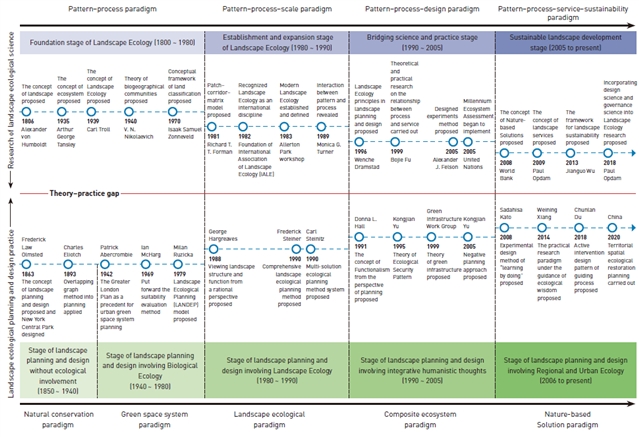
景观生态科学研究与景观生态规划设计实践的发展历程 © 朱宗斌,岳邦瑞
1)景观生态学奠基阶段(1800~1980年)。早期生态学、地理学独立发展,景观、生态系统等概念的提出为景观生态学的诞生奠定了基础。
2)景观生态学建立与扩展阶段(1980~1990年)。国际景观生态学会的成立标志着景观生态学成为国际性学科,景观生态学逐步建立并向“格局-过程-尺度”范式扩展。该阶段探讨了如何将景观生态学规划理论应用于土地利用和保护实践中。
3)科研与实践弥合阶段(1990~2005年)。景观生态学向应用领域不断拓展,景观生态学向“格局-过程-设计”范式扩展,进一步弥合了科学研究与实践应用之间的差距。
4)可持续景观发展阶段(2006年至今)。景观生态学从理论认知逐渐走向决策实践,开始强调生态与人类福祉、社会机制共生,促进可持续景观规划与发展。将景观生态学进一步拓展至“格局-过程-服务-可持续性”范式。
景观生态规划设计实践发展历程
景观生态规划设计是基于广义生态学原理,以协调人与自然关系为目标的各种尺度空间的规划与设计的总称,大致历经5个阶段:1)生态学未介入的景观规划设计实践阶段(1850~1940年);2)生物生态学介入的景观规划设计实践阶段(1940~1980年);3)景观生态学介入的景观规划设计实践阶段(1980~1990年);4)融合整体人文思想的景观生态学介入的景观规划设计实践阶段(1990~2005年);5)区域、城市生态学介入的景观规划设计实践阶段(2006年至今)。
景观生态规划设计实践发展历程
景观生态科学研究和景观生态规划设计实践两个领域的整合过程中,景观生态学的理论框架为景观规划设计提供信息,而设计原则和过程为景观生态学的理论框架提供反馈并进行扩展,景观生态规划设计实践由经验规划设计向循证规划设计转变。
03.景观生态规划设计研究体系
本文提出连接科学研究与规划设计实践的三层级研究体系:1)景观生态科学基础研究;2)景观生态规划设计应用基础研究;3)景观生态规划设计实践应用研究。
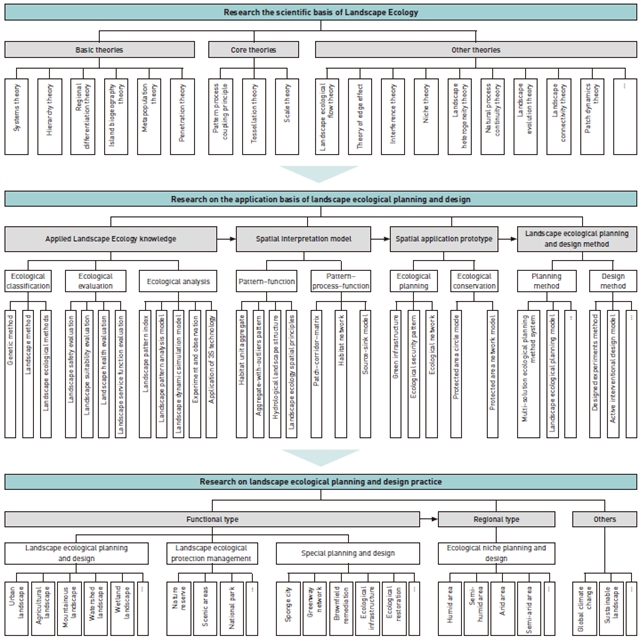
连接景观生态科学研究到景观生态规划设计实践的三级研究体系 © 朱宗斌,岳邦瑞
04.空间机制
本文提出,需通过景观生态规划设计应用基础研究这一纽带来弥合理论实践差距。本文引入“空间机制”(spatial mechanism)概念,提出两类空间机制:空间作用机制与空间约束机制。通过这两类空间机制分析,可以有效地实现景观生态学理论知识向具体设计和规划策略的转化。

空间机制分析框架链接了三级研究体系 © 朱宗斌,岳邦瑞
从景观生态学理论到空间应用原型
空间作用机制分析
景观规划设计实践一开始仅关注形式-功能关系,直到景观生态学中关于景观过程的研究打开了格局与功能之间的“黑箱”。后文重点展开对“格局-过程-功能”因果链条式空间作用机制的探究。
空间作用机制的可实践知识
本文通过“格局-过程-功能”因果链条分析路径,并以河流廊道(绿色基础设施)生态规划设计情境为例,进行因果链条机制简要分析。首先明确河流廊道的理想景观功能(洪水调节),其次重点分析对其产生影响的景观过程(河川径流过程),分析产生影响的关键结构特征(曲度、宽度),最后指向规划设计师可实践的河流廊道的纵、横、竖向景观结构,即通过空间作用机制分析得到理想格局。
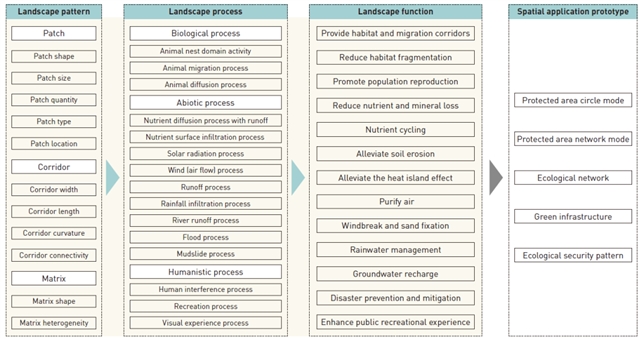
空间作用机制可实践知识框架 © 朱宗斌,岳邦瑞

河流廊道“格局-过程-功能”因果链条机制解析 © 朱宗斌,岳邦瑞
从空间应用原型到景观规划设计实践
空间约束机制分析
景观生态科学研究借助计算机、地理信息系统为规划设计师判断理想格局提供了一套高效且系统的方法。然而,以往研究大多把现状景观过程作为设计约束条件,进行被动式规划设计。
本文提出的空间约束机制空间约束机制更注重场地导向的实践优位与整体主义。空间约束限制分析涵盖规划设计师知识结构、创意能力及利益相关者功能需求等功能约束,气候条件、地质地貌条件等地域约束,以及场地地形、场地水文条件等场地约束的识别和应对。从初始的具有普适性和通用性的空间应用原型,到增加了特定功能属性和需求的功能类型,再到结合具体地域环境及地方性知识、具有复杂设计约束限制的生态规划设计类型,规划设计方案最终落位于场地。
场地的约束和限制非但不会阻碍创造力,反而能激发规划设计师的潜能,将遵循现状过程的被动式规划设计转变为干预景观过程的主动式规划设计。
空间约束机制的可实践知识
以西北干旱半干旱区海绵城市绿色基础设施生态规划设计情境为例,进行简要因果链条机制分析。首先明确了景观目标(雨洪调节),其次分析了影响景观目标的空间约束条件(土壤渗透性强、持水性差),进而提出了景观途径(开源节流)与具体的景观策略(水分条件分布优化、微地形、下凹绿地等)。
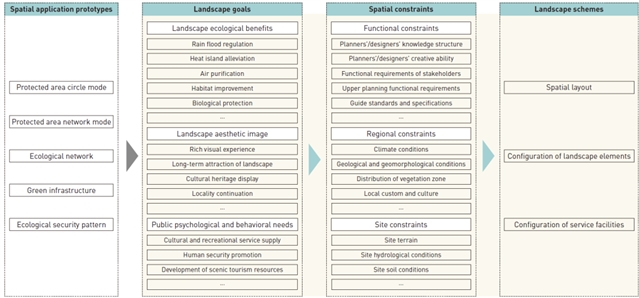
空间约束机制可实践知识框架 © 朱宗斌,岳邦瑞

干早区海绵城市“目标-约束-方案”因果链条机制解析 © 朱宗斌,岳邦瑞
05.景观生态规划设计程序
本文提出基于空间机制协同分析的景观生态规划设计程序。
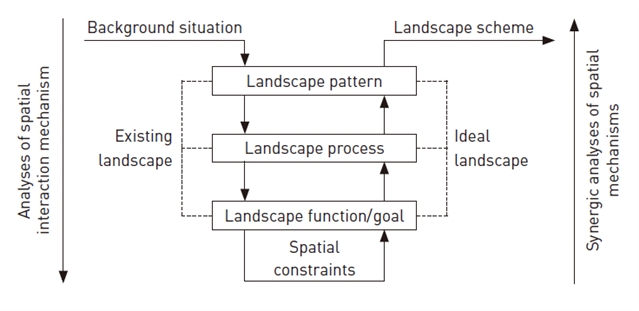
空间作用机制与空间约束机制协同分析的景观生态规划设计程序 © 朱宗斌,岳邦瑞
现状景观空间作用机制分析
基于格局-过程-功能因果链条式的空间作用机制分析阶段主要分为景观格局表述、景观过程分析和景观功能评价三个步骤。
1)景观格局表述:基于空间解释模型,建立现状景观的表述系统,包括气象、地形、水文、土地利用状况等。
2)景观过程分析:从生物过程、非生物过程、人文过程三方面对现状景观进行分析。
3)景观功能评价:对生态系统的健康与安全及生态系统服务的状况进行评价,分析现状景观格局对景观过程的利害,从而判断目前景观是否运转良好。
理想景观空间作用机制
与空间约束机制协同分析
基于“格局-过程-功能”因果链条式的空间作用机制与基于“目标-约束-方案”因果链条式的空间约束机制协同分析主要分为景观目标确定、景观过程分析和景观格局优化三个步骤。
1)景观目标确定:基于现状景观功能,结合空间约束确定景观目标(即理想景观功能)。
2)景观过程分析:基于景观目标推导出对应的理想景观过程。
3)景观格局优化:映射到影响特定景观过程的景观格局结构,提出规划设计方案。
06.三亚红树林生态公园 案例解析
本节以中国三亚红树林生态公园项目为例。三亚红树林生态公园位于三亚河东岸,季节性的水量不均导致旱季河道缺水。大量城市开发侵占了原有坑塘系统,造成了严重的城市内涝。从通过空间机制协同分析到提出枝杈状形态的景观提升方案的过程。具体策略包括:
1)水质提升策略:设计遵循场地现状水文过程,通过改变河道横向结构配置,形成层叠状湿地净化环的净水格局,即增加梯田、坑塘湿地,使城市中的雨水径流净化后排入河道。
2)生境修复策略:根据红树林生物特征(喜盐、易倒伏),分提出枝杈状的坑塘湿地格局,即通过改变河流廊道、驳岸等横/竖向景观结构,营造适宜红树林生长的生存环境。
3)休闲游憩策略:构建多维交通系统,形成不同的游憩体验。
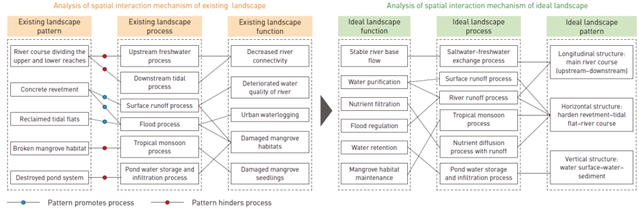
空间作用机制分析 © 朱宗斌,岳邦瑞
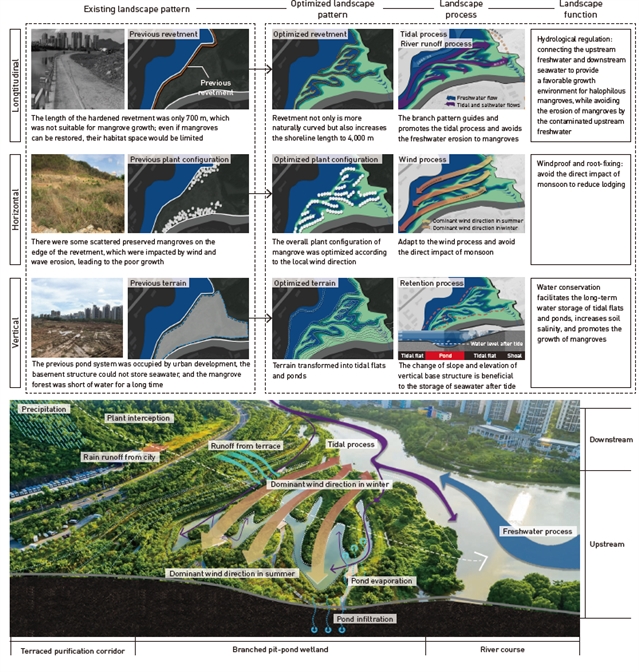
三亚红树林生态公园景观改造方案策略解析 © 朱宗斌,岳邦瑞
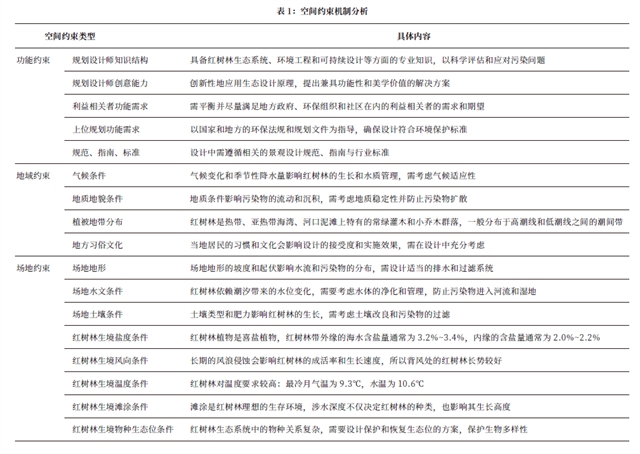
07.结语
本研究基于景观生态科学研究与景观生态规划设计实践历程回顾,建构了景观生态规划设计三层级研究体系,进一步指出空间机制分析打开了科学研究到实践应用转化途径中的“黑箱”,增强了景观生态规划设计的可解释性。
从景观生态学理论到空间应用原型,再到景观生态规划设计实践,是去语境化(科学研究语境)到再语境化(实践语境)的过程。需要指出的是,本文仅从景观生态科学研究向实践应用转化的单一向度探讨了二者的脱节错位问题,而未探讨生态智慧与计算机技术方法等。未来研究可从上述方面继续深化空间机制研究。
参考文献
[1] Wu, J. (2000). Landscape ecology: Concepts and theories. Chinese Journal of Ecology, 19(1), 42–52.
[2] Fu, B., Chen, L., Ma, K., & Wang, Y. (2011). Principles and Application of Landscape Ecology. Science Press.
[3] Pearson, D. (2024). Landscape ecology 40 years since Allerton Park: Looking back and to the future!. Landscape Ecology, 39(3), 46.
[4] Milovanovi?, A., Milovanovi? Rodi?, D., & Maruna, M. (2020). Eighty-year review of the evolution of landscape ecology: From a spatial planning perspective. Landscape Ecology, (35), 2141–2161.
[5] Hersperger, A. M., Gr?dinaru, S. R., Pierri Daunt, A. B., Imhof, C. S., & Fan, P. (2021). Landscape ecological concepts in planning: Review of recent developments. Landscape Ecology, (36), 2329–2345.
[6] Dong, J., Jiang, H., Gu, T., Liu, Y., & Peng, J. (2022). Sustainable landscape pattern: A landscape approach to serving spatial planning. Landscape Ecology, (37), 31–42.
[7] Yu, K. (1999). Landscape ecological security patterns in biological conservation. Acta Ecologica Sinica, 19(1), 8–15.
[8] Yue, B., & Kang, S. (2020). Review of the types and paradigms of landscape planning theories. Landscape Architecture, 27(3), 63–68.
[9] Wang, Z., & Li, M. (2016). How to frame design research paradigm of landscape architecture?. Chinese Landscape Architecture, (4), 10–15.
[10] Grose, M. J. (2014). Gaps and futures in working between ecology and design for constructed ecologies. Landscape and Urban Planning, (132), 69–78.
[11] Albert, C. H., Yoccoz, N. G., Edwards Jr, T. C., Graham, C. H., Zimmermann, N. E., & Thuiller, W. (2010). Sampling in ecology and evolution—Bridging the gap between theory and practice. Ecography, 33(6), 1028–1037.
[12] Wang, Z. (2018). Bridging the gaps between landscape design practice and scientific research: A graphical interpretation. Landscape Architecture Frontiers, 6(5), 66–71.
[13] Yu, K. (2020). Practice research: A paradigm for the innovation of knowledge and methodology. Landscape Architecture Frontiers, 8(4), 4–9.
[14] Yu, K. (2017). Deep forms for beautiful China. Urban Environment Design,(6), 324–326.
[15] Chen, C., Wang, Y., Jia, J., Mao, L., & Meurk, C. D. (2019). Ecosystem services mapping in practice: A Pasteur’s quadrant perspective. Ecosystem Services, (40), 101042.
[16] Xiang, W. (2017). Pasteur’s quadrant: An appealing ecophronetic alternative to the prevalent Bohr’s quadrant in ecosystem services research. Landscape Ecology, 32(12), 2241–2247.
[17] Cooke, S. J., Jeanson, A. L., Bishop, I., Bryan, B. A., Chen, C., Cvitanovic, C., Fen, Y., Forseter, J., Fürst, C., Hu, J., La Rosa, D., Meurk, C., Nguyen, V. M., Paolisso, M., Qi, Y., Chun, F. K. S., Szetey, K., Wang, X., Wang, Y., Archibald, C. L., & Young, N. (2021). On the theory-practice gap in the environmental realm: Perspectives from and for diverse environmental professionals. Socio-Ecological Practice Research, 3(3), 243–255.
[18]Knight, A. T., Cowling, R. M., Rouget, M., Balmford, A., Lombard, A. T., & Campbell, B. M. (2008). Knowing but not doing: Selecting priority conservation areas and the research–implementation gap. Conservation Biology, 22(3), 610–617.
[19]Ndubisi, F. (2013). Ecological Planning: A Historical and Comparative Synthesis.China Architecture & Building Press.
[20] Dramstad, W. E., Olson, J. D., & Forman, R. T. (2010). Landscape Ecology Principles in Landscape Architecture and Land-use Planning. China Architecture & Building Press.
[21] Nassauer, J. I., & Opdam, P. (2008). Design in science: Extending the landscape ecology paradigm. Landscape Ecology, (23), 633–644.
[22] Yue, B. (2017). Illustrated Principles of Landscape Ecological Planning and Design. China Architecture & Building Press.
[23] Wang, Y. (2017). The logical thinking and framework of landscape space pattern language. Landscape Architecture, (4), 89–98.
[24] Xiang, W. (2014). Doing real and permanent good in landscape and urban planning: Ecological wisdom for urban sustainability. Landscape & Urban Planning, (121), 65–69.
[25] Wang, Z. (2017). Ecophronesis and actionable ecological knowledge. Urban Planning International, 32(4), 16–21.
[26] Yu, K., Li, D., & Han, X. (2005). On the “negative planning”. City Planning Review, 29(9), 64–69.
[27]Si, Y., Fang, J., & Xu, L. (2021). Review of ecological infrastructure planning practices based on the ecological security pattern theory in China (1997 ~ 2019). Landscape Architecture Frontiers, 9(3), 28–47.
[28] Forman, R. T., & Godron, M. (1986). Landscape Ecology. John Wiley & Sons.
[29] Forman, R. T. (2015). Launching Landscape Ecology in America and Learning from Europe. In: G. W. Barrett, T. L. Barrett & J. Wu (Eds.), History of Landscape Ecology in the United States (pp. 13–30). Springer.
[30] Farina, A. (2022). Theories and Models Incorporated in Landscape Ecology. Principles and Methods in Landscape Ecology: An Agenda for the Second Millennium (pp. 111–156). Springer.
[31] Peters, D. P., Bestelmeyer, B. T., & Turner, M. G. (2007). Cross–scale interactions and changing pattern–process relationships: Consequences for system dynamics. Ecosystems, (10), 790–796.
[32] Forman, R. T. (1995). Land Mosaics: The Ecology of Landscapes and Regions. Cambridge University Press.
[33] Forman, R. T. (1995). Some general principles of landscape and regional ecology. Landscape Ecology, 10(3), 133–142.
[34] Felson, A. J., & Pickett, S. T. (2005). Designed experiments: New approaches to studying urban ecosystems. Frontiers in Ecology and the Environment, 3(10), 549–556.
[35] Millennium Ecosystem Assessment. (2005). Ecosystems and Human Well-being. Island Press.
[36] MacKinnon, K., Sobrevila, C., & Hickey, V. (2008). Biodiversity, climate change, and adaptation: Nature-based Solutions from the World Bank portfolio. World Bank.
[37] Wu, J. (2013). Landscape sustainability science: Ecosystem services and human well-being in changing landscapes. Landscape Ecology, (28), 999–1023.
[38] Opdam, P., Luque, S., Nassauer, J., Verburg, P. H., & Wu, J. (2018). How can landscape ecology contribute to sustainability science?. Landscape Ecology, (33), 1–7.
[39] Termorshuizen, J. W., & Opdam, P. (2009). Landscape services as a bridge between landscape ecology and sustainable development. Landscape Ecology, (24), 1037–1052.
[40] Wang, Y. (2013). Development history and trends of ecological planning method in Landscape Architecture. Chinese Landscape Architecture, (11), 46–51.
[41] Yu, B., Tian, S., & Che, S. (2013). From McHarg to Steinitz: Transmutation of theories and methods in the field of Landscape Architecture based on Landscape Ecology. Chinese Landscape Architecture, (4), 67–72.
[42] Yu, K. (1998). Challenges and opportunities faced by the Chinese Landscape Architecture profession from the perspective of the three stages of global Landscape Architecture development. Chinese Landscape Architecture, (1), 15–19.
[43] Yan, S., Ren, T., & Yang, H. (2013). A preliminary study on ecological paradigm in urban planning. Journal of Human Settlements in West China, (3), 37–42.
[44] Yu, B. (2012). Traces of ecologism in Western modern landscape planning and design [Doctoral dissertation]. Beijing Forestry University.
[45] Kato, S., & Ahern, J. (2008). ‘Learning by doing’: Adaptive planning as a strategy to address uncertainty in planning. Journal of Environmental Planning and Management, 51(4), 543–559.
[46] Forman, R. T. (2008). Urban Regions: Ecology and Planning Beyond the City. Cambridge University Press.
[47] Yue, B., & Fei, F. (2018). The transformation path from ecology language to landscape ecological planning and design language. Landscape Architecture, (1), 21–27.
[48] Yue, B., & Fei, F. (2018). Illustrated principles of landscape ecological planning and design: Teaching explorations on bridging theories with practice of landscape ecological planning and design. Landscape Architecture Frontiers, 6(5), 86–91.
[49]Liu, J., Zhang, L., & Chen, Z. (2011). Why social science needs to pursue causal mechanisms. Journal of Public Administration, (4), 50–84, 179.
[50]Lan, Z., Yue, B., & Wang, J. (2022). Analysis method and application of spatial mechanism in landscape ecological planning. Journal of Xi’an University of Architecture & Technology (Natural Science Edition), 54(1), 120–126.
[51] Yue, B., Qian, Z., & Yao, L. (2024). A spatial mechanism analysis framework for applying hydrological knowledge to landscape architecture design. Chinese Landscape Architecture, 40(1), 66–71.
[52] Fei, F., Yue, B., & Nie, J. (2023). Research progress and enlightenment of landscape perception from the perspective of ecological-aesthetic disjuncture. Chinese Landscape Architecture, 39(9), 120–125.
[53] Chen, Z., & Miller, P. A. (2013).Landscape Architecture towards evidence-based design: A lesson from research progress in United States. Chinese Landscape Architecture, 29(12), 48–51.
[54] Diamond, J. M. (1974). Colonization of exploded volcanic islands by birds: The supertramp strategy. Science, 184(4138), 803–806.
[55] Zou, J., & Du, C. (2018). Process-orientated active intervention design pattern: An exploration of the method inspired by ecological wisdom. Chinese Landscape Architecture, (7), 59–63.
[56] Wang, Z. (2023). A call for holism research in the realm of territorial spatial planning and landscape design. Landscape Architecture Frontiers, 11(6), 4–7.
[57] Yu, K. (2023). Antidote to tech dystopia: The Chinese model of Nature-based Solutions. Landscape Architecture Frontiers, 11(2), 4–9.
[58] Fu, B., Liu, G., Chen, L., Ma, K., & Li, J. (2001). Scheme of ecological regionalization in China. Acta Ecologica Sinica, 21(1), 1–6.
[59] Wang, F., Li, B., Tian, S., Zheng, D., & Ge, Q. (2024). Updated scheme for eco-geographical regionalization in China. Acta Geographica Sinica, 79(1), 3–16.
[60] Liu, H., Xu, B., Zou, Z., & Zuo, X. (2021). Greening design with water: The ecological design method of urban green space in Northwest China. Chinese Landscape Architecture, 37(7), 25–30.
[61] Yu, K. (2019). Large scale ecological restoration: Empowering the Nature-based solutions inspired by ancient wisdom of farming. Acta Ecologica Sinica, 39(23), 8733–8745.
[62] Zheng, Q., Yun, H., & Lin, H. (2024). Ecological designed experiment method based on pragmatism: A case study of Haizhu Wetland Restoration Project in Guangzhou, China. Landscape Architecture Frontiers, 12(1), 66–87.

前沿》系列英文学术期刊
由教育部主管、高等教育出版社主办的《前沿》(Frontiers)系列英文学术期刊,于2006年正式创刊,以网络版和印刷版向全球发行。系列期刊包括基础科学、生命科学、工程技术和人文社会科学四个主题,是我国覆盖学科最广泛的英文学术期刊群,其中12种被SCI收录,其他也被A&HCI、Ei、MEDLINE或相应学科国际权威检索系统收录,具有一定的国际学术影响力。系列期刊采用在线优先出版方式,保证文章以最快速度发表。
中国学术前沿期刊网
http://journal.hep.com.cn

特别声明:本文转载仅仅是出于传播信息的需要,并不意味着代表本网站观点或证实其内容的真实性;如其他媒体、网站或个人从本网站转载使用,须保留本网站注明的“来源”,并自负版权等法律责任;作者如果不希望被转载或者联系转载稿费等事宜,请与我们接洽。